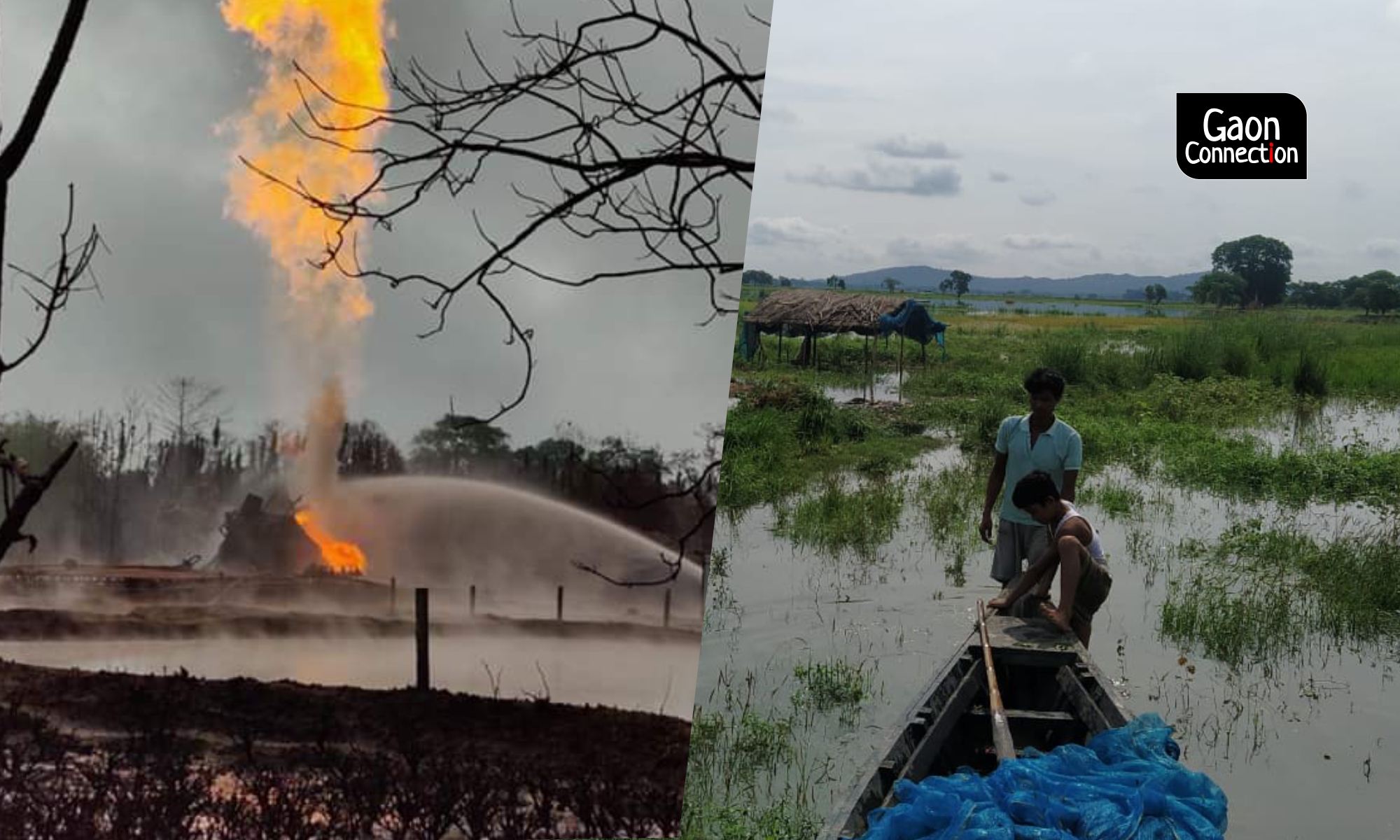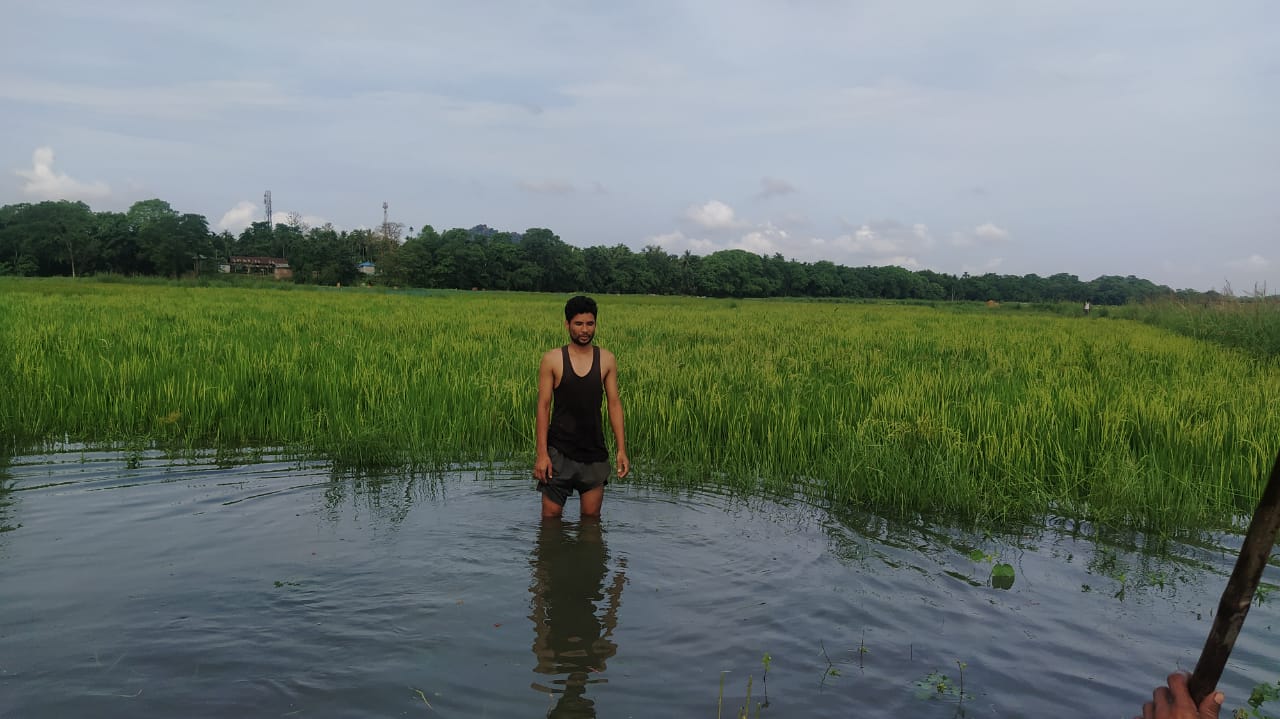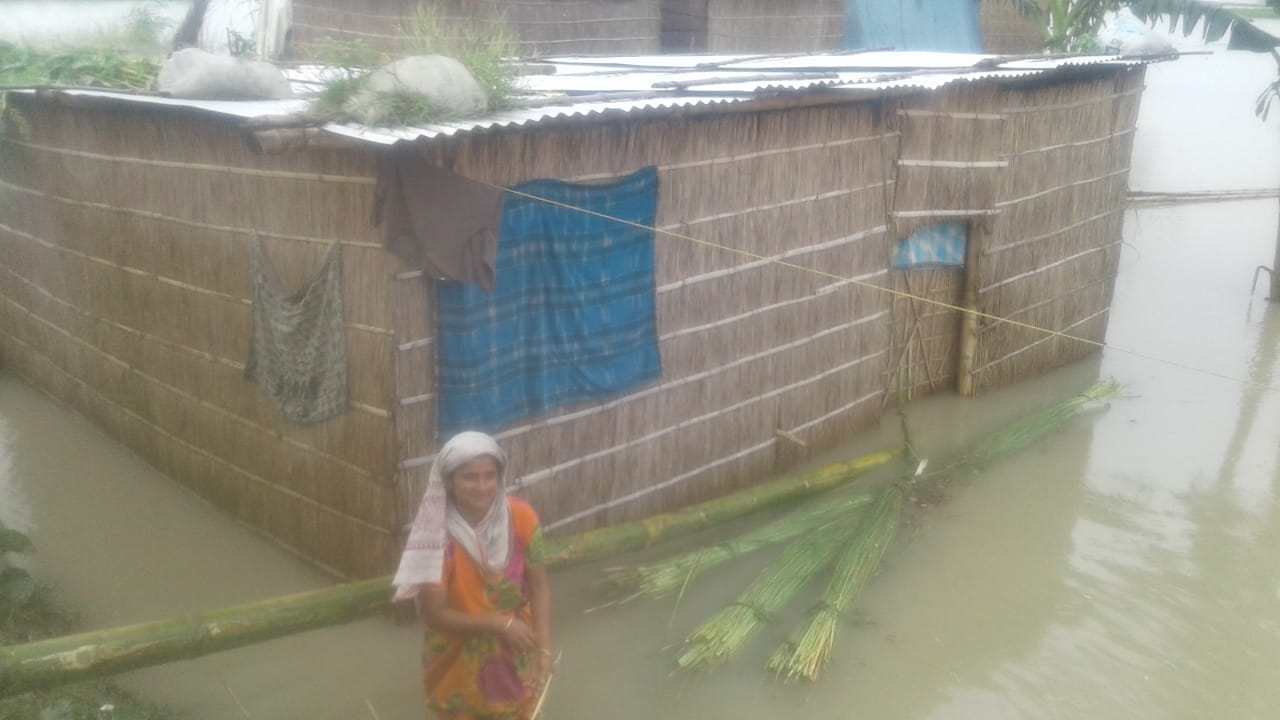2.5 million affected by floods; 24 dead in landslides; Baghjan oil well still on fire. Assam battling multiple disasters amid the COVID-19 pandemic
Every year during the monsoon, Assam faces floods. But this year the crisis has magnified, as the state is handling multiple disasters while the COVID-19 cases are also on the rise. The oil well at Tinsukia is on fire since June 9.

People in the region are braving both the floods and the impacts of the oil well fire.
Assam, the gateway to northeast India, is braving multiple disasters. Monsoon and heavy rainfall have brought massive floods to a number of its districts. The inundation has killed at least 40 people and affected over 2.5 million people, including lakhs of farmers, and damaged infrastructure and property worth crores of rupees. The state government has set up 156 relief camps, including 64 relief distribution centres across the state. There are over 12,000 flood-affected people in these relief camps.
“Despite the authorities being well prepared for the flood, which is an annual affair, managing the COVID-19 crisis along with the floods has posed a huge challenge,” M S Manivannan, chief executive officer of the Assam State Disaster Management Authority told Gaon Connection. “Setting and running these relief camps following the COVID-19 protocols have been a huge challenge. But, we have been able to manage,” he added.

Farmers worst hit
According to the disaster management authority, over 67,628 hectares of agricultural land in the state, including domesticated animals, have been affected in the ongoing floods.
“This year’s flood impacted farmers more since the COVID-19 crisis had already hit them hard financially. The supply chain of the farmers is also in tatters,” said Mawsam Hazarika, a senior official of the Assam agriculture department.
According to the 2011 Census there are 1,263,532 agricultural labourers in the state. “During the rabi season, farmers couldn’t engage labourers due to the COVID-19 guidelines. Lakhs of labourers were hit by this. If the current wave of flood hits farmers severely, these labourers will be impacted too,” added Hazarika.
Morigaon district is considered most vulnerable to flood and is among the worst affected this year. “This year, there has been a huge shortage of labourers due to the COVID-19 crisis. I couldn’t cultivate the entire 24 bighas [three hectares] of land I own,” Sosi Nanda Bordoloi, a 40-year-old farmer from Borsola village in Morigaon told Gaon Connection. Almost 10 bighas (1.3 hectares) of his farmland is at present affected by the flood.
But he still considers himself lucky as he grows the flood-resilient variety of rice.
“The Krishi Vikas Kendra under the Assam Agriculture University developed the Ranjit Sub 1 variety of rice that is flood resilient. It can remain submerged under water for 14 days without damage. I experimented and cultivated in a small portion of my land last year and the results were satisfactory, so this year I cultivated this variety of rice,” he informed.
He, however, suffered huge losses from the mustard cultivation in the rabi crop season. “I had planted mustard in 18 bigha [2.4 hectare] of land, but due to the lockdown guidelines, I couldn’t go to the field and failed to arrange workers even when the lockdown was relaxed. As a result, over half of the cultivation got damaged, and my loss is over two lakh rupees,” lamented Bordoloi.
Officials of the Assam agriculture department termed the use of flood-resilient rice variety as a positive development. “We have been making farmers aware about this variety through our district and sub-division offices and even distributed the seeds, but it will take time to cover the entire state. We have also set up community nurseries for this variety of rice with the intention of making these available to the farmers even in the remote areas,” said Hazarika.
However, all farmers are not fortunate like Bordoloi. “Agriculture has been a traditional livelihood for me, but it has become a gamble over the years. Whenever the flood is severe, I suffer huge losses, and this year the flood is severe,” 43-year-old Ramu Medhi, who own 20 bigha (2.6 hectares) land in Borsola village of Morigaon, told Gaon Connection.
Apart from agricultural land, the floods have also affected the wildlife in the state. The Kaziranga National Park, Pabitora Wildlife Sanctuary, and Orang National Park are flooded. As per the Assam forest department, out of the 223 forest camps in Kaziranga, 14 are affected due to the floods, three have been vacated and 47 animals in the park are affected.

Incessant rainfall and landslides
Massive landslides have rocked the state owing to the incessant rainfall, resulting in 24 deaths. On June 2, 21 people including four minors were killed due to landslides in separate incidents in Hailakandi, Cachar and Karimganj districts of the state.
Several landslides have also been reported in the Kamrup Metro district killing three people. So far, 24 people are dead due to these landslides.
According to a study by the Assam Engineering College, supported by the Assam State Disaster Management Authority, 366 sites in the state are vulnerable to landslide, and 74 per cent of these sites need immediate attention to prevent loss of human lives and property. This report is also critical on the issue of lack of vegetation cover on the hills and the fact that Guwahati does not have a scientifically-designed hill area drainage network.
“In many hills, the natural streams and other water bodies have been blocked for developmental activities, and these makes the hills unstable and thereby prone to landslide,” Bhagawat Pran Duarah, professor with the Department of Geological Sciences, Gauhati University told Gaon Connection.
The Kamrup Metro District Administration has issued repeated warnings to people living on and around hills to shift to safer places at the earliest.

A month and oil well still on fire
While the state administration is battling massive floods and the COVID-19 pandemic, Oil India Limited’s oil well at Baghjan in Tinsukia district, which started to leak on May 27, and caught fire on June 9, is still burning. People in the region are braving both the floods and the impacts of the oil well fire. The fire has affected nearby villages and agricultural land but, despite roping in experts, Oil India Limited, a public sector undertaking, has not been able to douse it. Due to the flood waters, operation to douse the fire has been suspended. The nearby rivers are overflowing and have submerged the pumps installed for extinguishing the fire at the mouth of the well.
Apart from causing devastation in the form of burning several houses in the adjoining areas and damaging agricultural land, the oil leakage has impacted nearby water bodies including the Maguri-Motapung Beel.
Both the wetland and the famed Dibru-Saikhowa National Park are located only some about 900 metres from the affected gas well. It is a biodiversity hotspot, home to 36 species of mammals, 500 species of birds, 105 species of butterflies and 108 species of fish.

Terming the damage from the well on the ecosystem irreversible, Partha Jyoti Das of Aaranyak, a leading organisation working on wildlife in Assam, said: “The restoration process will require two to three years of sustained efforts.”
Meanwhile, over 1,600 families affected by the oil well fire have been put up in four relief camps. After protests by these families, the company has committed to compensate the families whose houses were burnt down with a one-time compensation of Rs 20 lakh each. It has also announced a one-time compensation of Rs 30,000 to every family affected by the fire.
Predictably, affected people housed in the relief camps are staring at a dark future. “Most villagers are worried about their future as they will know the extent of damage only after the fire is doused and normalcy returns,” Hemanta Moran, an affected local, who is also associated with a local organization named Baghjan Gaon Milanjyoti Yuva Sangha, told Gaon Connection. He also complained the COVID-19 guidelines were not being followed in the relief camps and said more such camps should have been set up by the company.
“We want immediate compensation. We cannot stay at the relief camps indefinitely,” said Satyajit Moran, a local villager living in a relief camp.
The Assam Pollution Control Board initially acted tough on the Oil India Limited and on June 19 issued a closure notice to the Baghjan Oil Field Operations. But within four days, on June 23, it withdrew the notice giving the company a long rope.
The pollution control board had earlier issued the closure notice on the grounds that the company had been operating without prior permissions including the key “consent to establish” and “consent to operate” clearances.

However, the second notice said the company will have to apply for ‘consent to operate’ under Section 25 of the Water (Prevention And Control) Act 1974, and Section 21 of the Air (Prevention And Control) Act 1981 separately each for drilling, production and other installations along with an environmental management plan.
“They have to submit all the details of hazardous waste generated, disposed and treatment facilities as per the Hazardous and Other Waste (Management and Transboundary Movement) Rules, 2016,” reads the letter.
Meanwhile, the National Green Tribunal, on June 26, constituted an eight-member committee of experts to probe the blowout, subsequent fire at the Baghjan oil well and the damage it has caused to humans, wildlife and the environment. In an order passed during video conferencing, the tribunal has directed the company to deposit Rs 25 crore with the district administration as interim compensation for the damage.
Meanwhile, in a statement the Oil India Limited has said it is willing to financially compensate all the damages that have been caused due to the fire.
But, can these ecological damages be compensated?

